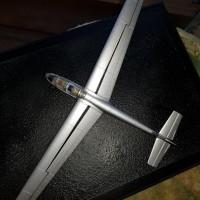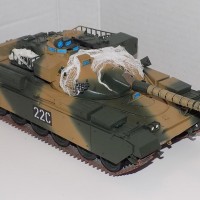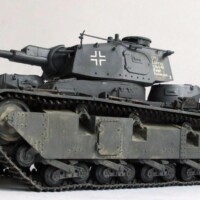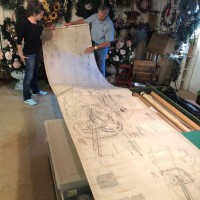Italeri 1/72 F-104G Starfighter
The origins of the “G” version of the Starfighter can be traced back in 1957, when the German Air Staff issued a Paper asking for a single aircraft to fulfill its fighter, fighter-bomber and reconnaissance mission requirements.
The resulting F-104G "Super Starfighter" would feature a more powerful J79-11A engine, a larger tail with powered rudder (the same used on the two-seat F-104B and D), upgraded blown flaps with a mode for improved maneuverability, electric de-icing equipment for the air intake inlets and a larger drag chute.
Greece was one of the nations that would receive the F-104G through the Military Assistance Program (MAP). Starting from April 1964, the planes arrived in Greece by ship and then were assembled at the nearby Hellenic Aircraft Factory. 42 examples were initially received, supplemented by another 10 not long after.
The type equipped the 335 and 336 Royal Hellenic Air Force (RHAF) Squadrons and was mainly used in the strike/bomber role, being a leading edge platform for more than a decade. During the first couple of its operational years, the plane was assigned to carry the B61 thermonuclear free-fall weapon on the fuselage centerline.
The Starfighter's advanced design brought new, demanding maintenance requirements, with the Hellenic Air Force taking brave leaps forward in order to adopt radical maintenance practices, such as the establishment of a separate Aircraft Maintenance Squadron, a policy which was then standardized to all its combat wings.
Though demanding to fly, requiring total commitment and respect, the plane was loved by HAF pilots. Roof, rate of climb and acceleration were second to none with the ‘shaker-kicker” system being there to assist the pilot in case the angle of attack's (short) limits were exceeded. Those who flew it said it was an excellent plane, albeit it did not give you time to think. When treated right, it was just fantastic, when not, it would viciously bite.
It is true that the Starfighter is commonly regarded as a partially successful platform. To take Tom Cleaver's @tcinla words,”this common wisdom might not be totally wise”, since with appropriate tactics that would make use of its particular qualities to their full potential, the plane would perform notably well.
This is the venerable 1981 Esci mold.
The specific kit is the 2023 Italeri edition, being a 2024 Christmas present from my friend George Blair @gblair. Our friend John vd Biggelaar @johnb received the same present from George and the three of us built the same kit around Christmas, each one in a livery of the builder's country.
Should you wish to read my Starfighter's full build review, you may do so by visiting my beloved site Modelingmadness:
https://modelingmadness.com/review/korean/us/usaf/fighter/penf104.htm
Happy Modelling!




















Slick-looking build of the Starfighter!
Thanks a lot, my friend @gkittinger!
A sharp looking Starfighter, Spiros @fiveten
I really like how it looks in Greek scheme.
It was a real pleasure to join you on this build.
Thanks so much, my friend @johnb! It was a pure pleasure to join you, as well!
Classic look to a classic aircraft. Well done, Spiros
Thanks a lot, my friend @gwskat!
Very nice Spiros
Thank you very much, my friend @blackadder57!
It’s a beauty Spiros @fiveten! Great idea to build it in three versions, the three of you.
Thanks a lot, my friend @hptiggelaar!
look so good Spiros (@fiveten)! beauty "Spillone" (in Italy we say)
Grazie amico mio @dapo68!
Excellent work and result on an old kit. A very informative article on Greek use as well.
Thanks so much, my friend @christopher!
Great write-up, Spiros, and great model, joining @gblair and @johnb in this group build.
Thank you so much, my friend @chinesegeorge!
Beautiful buld and superb article! Much respect to the brave men flying this unforgiving beast.
Thank you very much, my friend @bobd56az!
Awesome as always. Another good write up too, Spiros @fiveten
Thanks a lot, my friend @eb801!
Spiros (@fiveten),
Reading your build blog and looking at the final result is a good guide for making a F-104 kit. Your article and how you formatted the photos with your written article work well in showing off your model to good effect.
I'm still working my build weekends only. Getting ready to spray Tamiya clear followed by decals. Some strong "Greek" modeling going on.
Thank you kindy, my friend @stephen-w-towle!
Looking forward to yours, which looks awesome so far!
Nice one matey. It's always been an interesting looking cab. I think of is as a US English electric Lightning.
Goes like the clappers and doesn't suffer fools...not that I have flown either
Someone once told me that really, it's crash rate wasn't that different to the Jaguar. It just either got more publicity, or occurred in a more compressed time frame.
Helicopters have their attractions. Give me a DHC Beaver any day
Thanks so much, my friend @chrisballard! Never met a colleague who did not unconditionally love his Starfighter. Once they respected it, there was no better aircraft.
Great job, Spiros. Cockpit’s looking sharp!
Thanks my friend @bapowellphys!
You've made a beautiful Starfighter out of this old ESCI kit, my friend Spiros!
The result clearly shows your building skills. Definitely like the camo scheme. Sprayed freehand I presume?
Interesting write-up as well. Nice to learn that a number of RNLAF F-104G’s got a second life in Greece back then.
@fiveten
Thank you kindly, my friend @alfred! Yes, camo is freehanded.
Gorgeous build, Spiros @fiveten. I remember being a kid in Patras around 1987 and seeing them fly over me. I love the hellenic 3 color scheme, and you did a great job with it.
Thanks a lot, my friend @fxrob! The F-104s flying were quite a sight!
Nice work on the model and the article. I never knew how different the G was from the C. It was interesting to watch the group build you , John, and George did.
Thanks so much, my friend @ssgt!
Again, wonderful work, my friend. I follow your builds with enthusiasm, even though I don't know much about jet aircraft.
Thank you kindly as always, my friend @milantesar!
Beautiful!
Thanks a lot, my friend @butchbryan!